The Battle of the P67 Boards - ASUS vs. Gigabyte at $190
by Ian Cutress on January 20, 2011 4:15 PM EST- Posted in
- Motherboards
- Gigabyte
- Asus
- P67
Board Features
| Gigabyte P67A-UD4 | |
| Market Segment | Performance |
| CPU Interface | LGA 1155 |
| CPU Support | i3/i5/i7 Sandy Bridge |
| Chipset | P67 |
| Base Clock Frequency | 80 MHz to 200 MHz in 0.1 MHz increments |
| DDR3 Memory Speed | 1333 MHz by default, 800-2133 MHz supported |
| Core Voltage | Auto, 0.750V to 1.700V in 0.005V intervals |
| CPU Clock Multiplier | Dependant on CPU |
| DRAM Voltage | Auto, 0.90V to 2.60V in 0.020V intervals |
| DRAM Command Rate | Auto, 1N to 3N |
| Memory Slots |
Four 240-pin DDR3 DIMM slots in dual-channel Regular unbuffered DD3 memory Up to 32GB total supported |
| Expansion Slots |
2 x PCI Express 2.0 x16 slots (PCIe 1 operates at x16 in single mode, PCIe 2 operates at x8 in single mode, or x8/x8 in dual) 3 x PCI Express 2.0 x1 slots 2 x PCI slots Supports ATI Crossfire Supports NVIDIA SLI |
| Onboard SATA/RAID |
a) 2 x SATA 6.0 Gb/s ports (white) supporting RAID 0, 1, 5 and 10 b) 4 x SATA 3.0 Gb/s ports (black) supporting RAID 0, 1, 5 and 10 c) 2 x eSATA 3.0 Gb/s ports from Marvell 88SE9128, RAID 0, 1 a) + b) are capable of cross channel RAID 0, 1, 5, 10 |
| Onboard |
4 x SATA 3 Gb/s w/ RAID 2 x SATA 6 Gb/s w/ RAID 2 x eSATA 6 Gb/s w/ RAID 1 x Front panel audio header 1 x S/PDIF Out header 3 x USB 2.0/1.1 headers 1 x USB 3.0/2.0 header via Renesas (NEC) D720200 chip 1 x Serial port header 1 x Clearing CMOS jumper |
| Onboard LAN | Gigabit Ethernet via Realtek RTL8111E |
| Onboard Audio | 7.1 channel Realtek ALC892 codec |
| Power Connectors |
24-pin EATX Power connector 8-pin EATX 12V Power connector |
| Fan Headers |
1 x CPU fan header 2 x System fan headers 1 x Power fan header |
| I/O Panel |
1 x PS/2 keyboard/mouse port 1 x Coaxial S/PDIF Out connector 1 x Optical S/PDIF Out connector 8 x USB 2.0/1.1 ports 2 x USB 3.0/2.0 ports via Renesas (NEC) D720200 chip 2 x eSATA 6Gb/s ports 1 x RJ-45 port 8-channel Audio I/O ports |
| BIOS Revision | F7 Beta |
In the Box
- I/O shield
- SLI 3-slot bridge
- 4 x right-angled SATA connectors
Compared to the ASUS P8P67 Pro, both boxes do not come with much in the way of extra peripherals. Here we get an SLI 3-slot bridge (compared to the 2-slot on the ASUS) but lose the USB 3.0 rear bracket, meaning that one will have to be obtained in order to use the USB 3.0 header on the Gigabyte board.
Software
Smart 6
Smart 6 tries to encapsulate a good portion of the myriad of software available in easy-to-use quick buttons, and is essentially identical to the X58 and P55 iterations of the software. The QuickBoot portion attempts to speed up boot times by bypassing the lengthy BIOS post, assuming there has been no physical hardware change. QuickBoost is a single screen overclocking utility, similar to the EasyTune6 front page. Recovery2 helps roll back the system to a previous set of settings without predefinition of a backup time flag, and also the TimeLock, which is almost superfluous given Windows7 has Parental Controls.
The idea behind TimeLock is similar to that on the Xbox360 parental controls – specify a certain number of hours per day (in this case, two different values for weekdays and weekends) for which the computer can be in use.
@BIOS
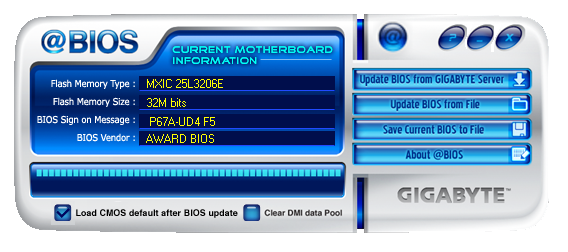
@BIOS is the staple Gigabyte BIOS update utility, and has been for a few iterations now. Users should note that to flash the latest BIOS files, the version of @BIOS on the CD is insufficient, and @BIOS 2.1 is required. 2.1 can be downloaded from the Gigabyte website.
Dynamic Energy Saver 2
Another program that Gigabyte has been using on various chipsets is the Dynamic Energy Saver 2. As you can see from the picture, various power saving features can be enabled or disabled through user settings, or you can let the software determine the best course of action.
EasyTune6
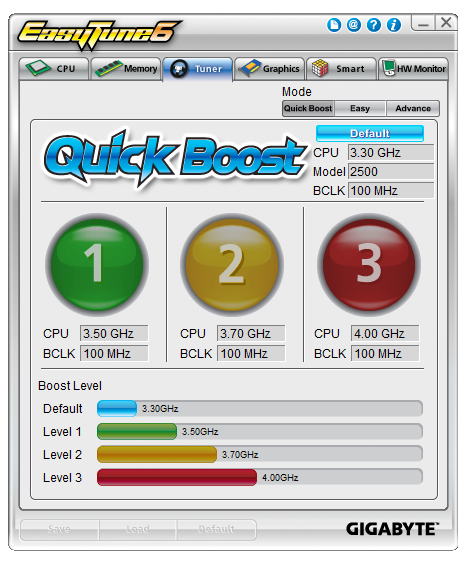
The OS overclocking tools are predominantly housed in EasyTune6. The front screen has those easy to use OC buttons, but only having three up to 4 GHz is somewhat limiting on the Sandy Bridge platform, given that most processors will happily do 4.4 GHz plus. There is no system of auto-overclocking detection similar to the ASUS boards.

Despite the software having an option for ‘real time ratio change’, of which there is an option in the BIOS to enable/disable, I could not get this to work. Upon setting a new multiplier, I was asked to reboot to apply it.
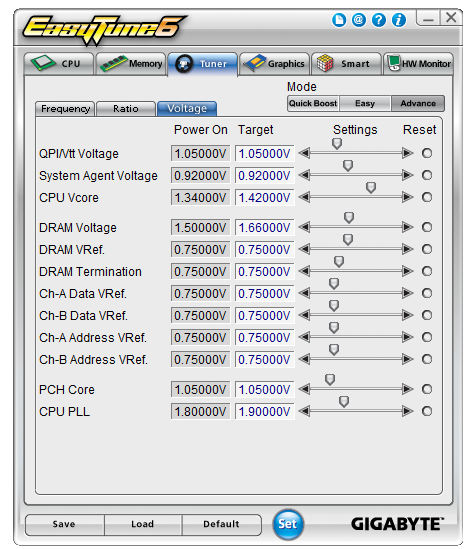
As always with EasyTune6, going to advance mode allows voltage manipulation. While it is nice to have such a wide variety of options, given that for Sandy Bridge all you really need is CPU VCore, DRAM and CPU PLL, it would have been easy just to include those in the ‘easy’ mode.

Fan control is basic in EasyTune6. Even in advanced mode, as shown above, you can choose where to put the initial and final ramp positions in terms of temperature against max RPM, but there is no option to define further points on the curve, or no determination of separate fans, so all chassis fans will be controlled by this one profile.



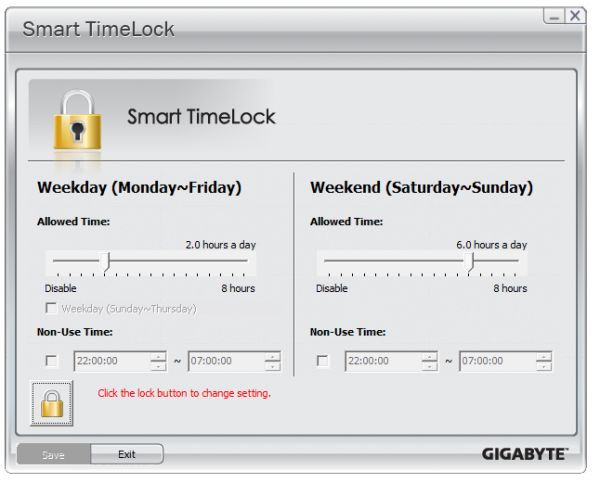
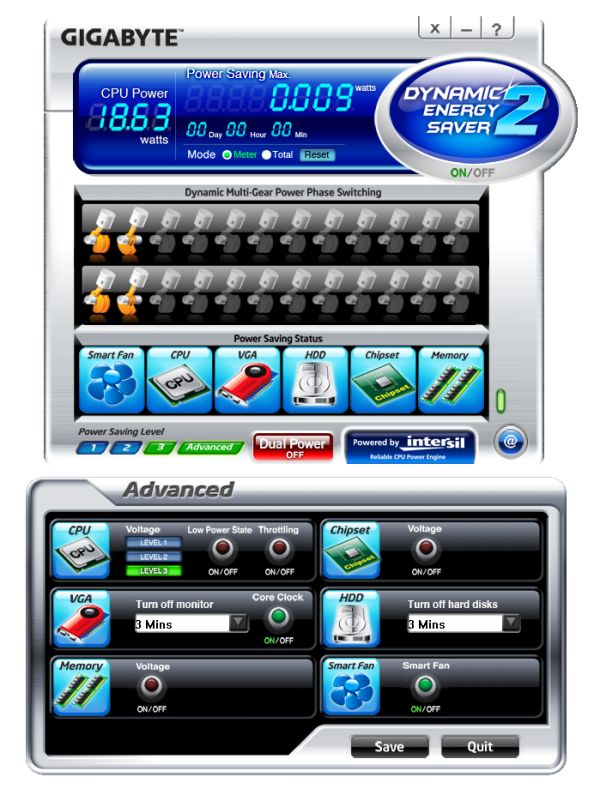








137 Comments
View All Comments
7Enigma - Tuesday, January 25, 2011 - link
And in my experience I'm on the exact opposite. Built a gaming computer for my dad last summer. Started to randomly refuse to turn on after 2 months of use normal. After ruling out peripherals I pulled the HSF off and popped the CPU out to see a DISCONNECTED PIN on the mobo! Just sitting there on the ground like it had decided to fall off. Contacted Gigabyte through Newegg and received NO response. TONS of people were having similar issues both on their forums and on Newegg. I never received a response from them and ended up shelving the $130 mobo in my basement and buying a $140 Asus which has been rock-solid since installation last fall.Prior to this lack of customer support I was a huge fan of Gigabyte. My last 2 mobo's and video card were from them and I had nothing but praise when asked for a recommendation by friends/family. After the mobo fiasco and clearly being ignored (both myself and other enthusiasts) I've sworn off the company.
Makaveli - Thursday, January 20, 2011 - link
was that 920 D0 at stock speeds for the gaming test or overclocked?MeanBruce - Thursday, January 20, 2011 - link
Really feel it's worth waiting for the SandyBridge E LGA-2011 Asus Rampage IV Extreme X68 with Quad memory. That mobo will last through Ivy Bridge 22nm and maybe even into Haskins! In the meantime think I'll drive over to motor city and pick up some new rocks.vol7ron - Thursday, January 20, 2011 - link
Mmmm quad mem.Gothmoth - Thursday, January 20, 2011 - link
honest the H67 and P67 boards, as good as they are, are only to suck the money from the dumb enthusiasts who will not wait for the REAL DEAL.im not buying this stuff from, intel im waiting for Z68.
this overclocking/quick sync sillyness with the current chipsets really sux.
don´t know what intel is thinking but im not buying this crap thats for sure.
vol7ron - Thursday, January 20, 2011 - link
Second. It's actually a good marketing move to get rid of old partsMeanBruce - Thursday, January 20, 2011 - link
Mmmm Z68...strikeback03 - Friday, January 21, 2011 - link
Well, for some users the current offerings do make sense. If you are building a pure gaming system P67 shouldn't limit you any, as QuickSync isn't likely to be that important to you. Or our work computers, for example, will never be overclocked, so H67 boards would be fine for that use.That said, any mild enthusiast building some form of general-purpose system should probably wait for Z68. Dunno how Intel screwed that up, but it was dumb.
7Enigma - Tuesday, January 25, 2011 - link
Here here. I'll read the reviews for Anandtech but wouldn't touch this junk with a 10 foot pole. All the mobo manufacturers should be ticked at Intel for pulling this stunt as it doesn't affect them, just us as the end users and the mobo companies.GoodBytes - Thursday, January 20, 2011 - link
I agree with Beenthere.Since 2003-04 I notice ASUS cut on quality like no tomorrow. And their RMA service (well at least in Canada) is non-existant. Staff are rude, don't want to work, takes a month to process a replacement (this is NOT one of those once in a life time experience, this happened to me twice, and friends), and you get at the end someone else RMA'ed board with a different problem and packed with dust. When I got that as a second time, now they draw the line. I switch to Gigabyte. The boards feel quality over ASUS high-end boards, and unlike ASUS boards, they don't break soon after the warranty.
So yes, Gigabyte boards are more expensive for what you get in term of features, but in terms of life span and quality, Gigabyte wins by far. And I used to be a ASUS-fan, hence why I closed my eyes on my first bad experience, and the ones of my friends. Idiot I was.
When Gigabyte said that ASUS boards where crap.. they were not kidding... When that was said I was like most people "Pfff what are they talking about"... and now I see how crappy the boards are.
I really don't get what's so special about ASUS, and I am tiered of reviews who ignore quality and long term usability. Did the reviewer tested the computer to go into sleep, and hibernate several time in a row, and long period of sleep for a week, to see if the board wake up, and that EVERYTHING is fully function (every USB, Ethernet port(s) and eSATA (if any))? Does the review test the board under stress for really long time. How about leaving the computer turned on for a week, no reboot, how many time if failed (if any). How about heat dispersion, to ensure that the board can last longer over 3 years in a state of being overclocked. All this is ignored by all review sites... They all cover the same things... performance, warranty by years (and not actually SEEING how the server is, and the time it takes for a replacement), how it overclocks, and features numbers.
These are the moment where I wish that if I had more time, I would collect resources and start my own review site. But the problem is I am already anti-ASUS... so I can't even be legitimate.